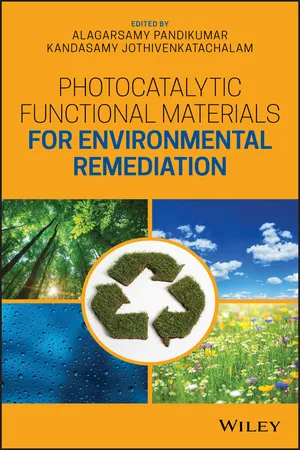
Photocatalytic Functional Materials for Environmental Remediation
- English
- ePUB (mobile friendly)
- Available on iOS & Android
Photocatalytic Functional Materials for Environmental Remediation
About This Book
A comprehensive volume on photocatalytic functional materials for environmental remediation
As the need for removing large amounts of pollution and contamination in air, soil, and water grows, emerging technologies in the field of environmental remediation are of increasing importance. The use of photocatalysis—a green technology with enormous potential to resolve the issues related to environmental pollution—breaks down toxic organic compounds to mineralized products such as carbon dioxide and water. Due to their high performance, ease of fabrication, long-term stability, and low manufacturing costs, photofunctional materials constructed from nanocomposite materials hold great potential for environmental remediation.
Photocatalytic Functional Materials for Environmental Remediation examines the development of high performance photofunctional materials for the treatment of environmental pollutants.
This timely volume assembles and reviews a broad range of ideas from leading experts in fields of chemistry, physics, nanotechnology, materials science, and engineering. Precise, up-to-date chapters cover both the fundamentals and applications of photocatalytic functional materials. Semiconductor-metal nanocomposites, layered double hydroxides, metal-organic frameworks, polymer nanocomposites, and other photofunctional materials are examined in applications such as carbon dioxide reduction and organic pollutant degradation. Providing interdisciplinary focus to green technology materials for the treatment of environmental pollutants, this important work:
- Provides comprehensive coverage of various photocatalytic materials for environmental remediation useful for researchers and developers
- Encompasses both fundamental concepts and applied technology in the field
- Focuses on novel design and application of photocatalytic materials used for the removal of environmental contaminates and pollution
- Offers in-depth examination of highly topical green-technology solutions
- Presents an interdisciplinary approach to environmental remediation
Photocatalytic Functional Materials for Environmental Remediation is a vital resource for researchers, engineers, and graduate students in the multi-disciplinary areas of chemistry, physics, nanotechnology, environmental science, materials science, and engineering related to photocatalytic environmental remediation.
Frequently asked questions
Information
1
Titanium Dioxide and Carbon Nanomaterials for the Photocatalytic Degradation of Organic Dyes
Abbreviations
- A
- absorbance
- AC
- activated carbon
- Ads
- adsorption
- AOP
- advanced oxidation process
- BC
- brilliant blue dye
- BG
- brilliant green dye
- C
- dye concentration
- CB
- carbon black
- cb
- conduction band
- CDs
- carbon dots
- CNFs
- carbon nanofibers
- CNTs
- carbon nanotubes
- CQDs
- carbon quantum dots
- DSAC
- date stone‐activated carbon
- ETAD
- Ecological and Toxicological Association of Dyestuffs and Manufacturing Industry
- eV
- electron volt
- GAs
- graphene aerogels
- GO
- graphene oxide
- GrF
- graphite felt
- h
- Plank's constant
- k a
- the equilibrium constant of the reactant
- k r
- the specific reaction rate constant
- L:TiO2
- lysozyme‐coated TiO2 nanoparticles
- LD
- lethal dose
- MB
- methylene blue
- MO
- methyl orange
- N‐doped CDs
- nitrogen doped carbon dots
- Ox
- oxidation
- PCNFs
- porous carbon nanofibers
- PHF
- polyhydroxy fullerenes
- PVA
- polyvinyl alcohol
- r
- reaction rate for the oxidation of reactant
- Red
- reduction
- RhB
- rhodamine B
- TiO2@C
- TiO2@activated carbon nanocomposite
- TiO2@CF
- carbon felt supported TiO2
- vb
- valence band
- XRD
- X‐ray powder diffraction
- α
- alpha
- β
- beta
- λ em
- emission wavelength
- λ ex
- excitation wavelength
1.1 Introduction
Table of contents
- Cover
- Table of Contents
- List of Contributors
- Preface
- 1 Titanium Dioxide and Carbon Nanomaterials for the Photocatalytic Degradation of Organic Dyes
- 2 Visible Light Photocatalytic Degradation of Environmental Pollutants Using Metal Oxide Semiconductors
- 3 Contemporary Achievements of Visible Light‐Driven Nanocatalysts for the Environmental Applications
- 4 Application of Nanocomposites for Photocatalytic Removal of Dye Contaminants
- 5 Photocatalytic Active Silver Phosphate for Photoremediation of Organic Pollutants
- 6 Plasmonic Ag‐ZnO: Charge Carrier Mechanisms and Photocatalytic Applications*
- 7 Multifunctional Hybrid Materials Based on Layered Double Hydroxide towards Photocatalysis
- 8 Magnetically Separable Iron Oxide‐Based Nanocomposite Photocatalytic Materials for Environmental Remediation
- 9 Photo Functional Materials for Environmental Remediation
- 10 Graphitic Carbon Nitride‐Based Nanostructured Materials for Photocatalytic Applications
- 11 Metal–Organic Frameworks for Photocatalytic Environmental Remediation
- 12 Active Materials for Photocatalytic Reduction of Carbon Dioxide
- End User License Agreement